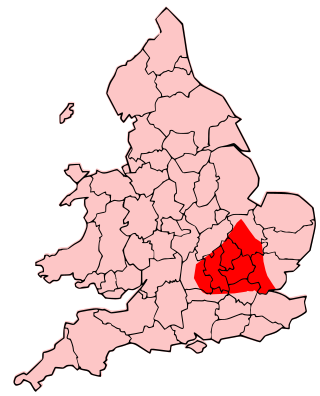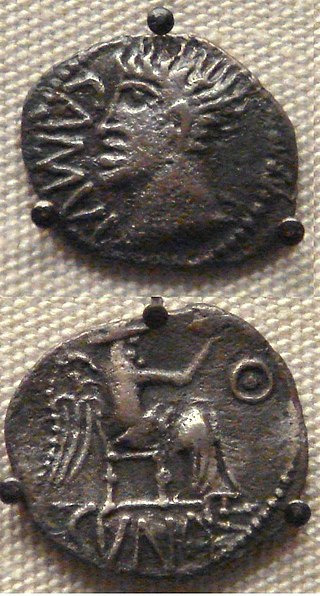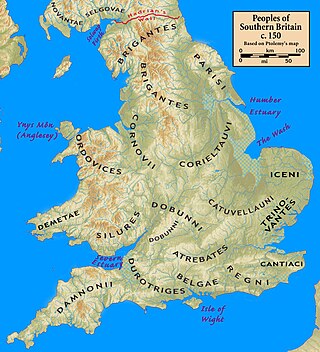Related Research Articles

Roman Britain was the territory that became the Roman Province of Britannia after the Roman conquest of Britain, consisting of a large part of the island of Great Britain. The occupation lasted from AD 43 to AD 410.

The Trinovantēs or Trinobantes were one of the Celtic tribes of Pre-Roman Britain. Their territory was on the north side of the Thames estuary in current Essex, Hertfordshire and Suffolk, and included lands now located in Greater London. They were bordered to the north by the Iceni, and to the west by the Catuvellauni. Their name possibly derives from the Celtic intensive prefix "tri-" and a second element which was either "nowio" – new, so meaning "very new" in the sense of "newcomers", but possibly with an applied sense of vigor or liveliness ultimately meaning "the very vigorous people". Their capital was Camulodunum, one proposed site of the legendary Camelot.
The Atrebates were a Belgic tribe of the Iron Age and the Roman period, originally dwelling in the Artois region.

The Cantiaci or Cantii were an Iron Age Celtic people living in Britain before the Roman conquest, and gave their name to a civitas of Roman Britain. They lived in the area now called Kent, in south-eastern England. Their capital was Durovernum Cantiacorum, now Canterbury.

The Catuvellauni were a Celtic tribe or state of southeastern Britain before the Roman conquest, attested by inscriptions into the 4th century.

The Belgae were a large confederation of tribes living in northern Gaul, between the English Channel, the west bank of the Rhine, and the northern bank of the river Seine, from at least the third century BC. They were discussed in depth by Julius Caesar in his account of his wars in Gaul. Some peoples in southern Britain were also called Belgae and had apparently moved from the continent. T. F. O'Rahilly believed that some had moved further west and he equated them with the Fir Bolg in Ireland. The Roman province of Gallia Belgica was named after the continental Belgae. The term continued to be used in that region and, much later, the modern country of Belgium was named after them.

Cunobeline was a king in pre-Roman Britain from about AD 9 until about AD 40. He is mentioned in passing by the classical historians Suetonius and Dio Cassius, and many coins bearing his inscription have been found. He controlled a substantial portion of south-eastern Britain, including the territories of the Catuvellauni and the Trinovantes, and is called "King of the Britons" by Suetonius. He appears to have been recognized by Roman emperor Augustus as a client king, as testified by the use of the Latin title Rex on his coins. Cunobeline appears in British legend as Cynfelyn (Welsh), Kymbelinus or Cymbeline, as in the play by William Shakespeare.
Cassivellaunus was a historical British military leader who led the defence against Julius Caesar's second expedition to Britain in 54 BC. He led an alliance of tribes against Roman forces, but eventually surrendered after his location was revealed to Julius Caesar by defeated Britons.

Commius was a king of the Belgic nation of the Atrebates, initially in Gaul, then in Britain, in the 1st century BC.

The Roman client kingdoms in Britain were native tribes which chose to align themselves with the Roman Empire because they saw it as the best option for self-preservation or for protection from other hostile tribes. Alternatively, the Romans created some client kingdoms when they felt influence without direct rule was desirable. Client kingdoms were ruled by client kings. In Latin these kings were referred to as rex sociusque et amicus, which translates to "king, ally, and friend". The type of relationships between client kingdoms and Rome was reliant on the individual circumstances in each kingdom.

The Venetī were a Gallic tribe dwelling in Armorica, in the northern part of the Brittany Peninsula, during the Iron Age and the Roman period.

Devil's Dyke is the remains of a prehistoric defensive ditch which lies at the east side of the village of Wheathampstead, Hertfordshire, England. It is protected as a Scheduled Monument. It is generally agreed to have been part of the defences of an Iron Age settlement belonging to the Catuvellauni tribe of Ancient Britain. It has possible associations with Julius Caesar's second invasion of Britain
Mandubracius or Mandubratius was a king of the Trinovantes of south-eastern Britain in the 1st century BC.
The Ancalites were a tribe of Iron Age Britain in the first century BCE. They are known only from a brief mention in the writings of Julius Caesar. They may have been one of the four tribes of Kent, represented in Caesar by references to the "four kings of that region" and in the archaeological record by distinct pottery assemblages.
The names of the Celtic Iron Age tribes in Britain were recorded by Roman and Greek historians and geographers, especially Ptolemy. Information from the distribution of Celtic coins has also shed light on the extents of the territories of the various groups that occupied the island.
The Segontiaci were a tribe of Iron Age Britain in the first century BCE. They are known only from a brief mention in the writings of Julius Caesar. They may have been one of the four tribes of Kent, represented in Caesar by references to the "four kings of that region" and in the archaeological record by distinct pottery assemblages.

In the course of his Gallic Wars, Julius Caesar invaded Britain twice: in 55 and 54 BC. On the first occasion Caesar took with him only two legions, and achieved little beyond a landing on the coast of Kent. The second invasion consisted of 628 ships, five legions and 2,000 cavalry. The force was so imposing that the Britons did not dare contest Caesar's landing in Kent, waiting instead until he began to move inland. Caesar eventually penetrated into Middlesex and crossed the Thames, forcing the British warlord Cassivellaunus to surrender as a tributary to Rome and setting up Mandubracius of the Trinovantes as client king.
The Cenimagni were a tribe of Iron Age Britain in the first century BCE. They are known only from a brief mention in the writings of Julius Caesar. It has been suggested that the name is a variant of Iceni with the Latin adjective magni, meaning "great". Others have suggested that they may have been one of the four tribes of Kent, represented in Caesar by references to the "four kings of that region" and in the archaeological record by distinct pottery assemblages.
The Bibroci were a tribe of Iron Age Britain in the first century BCE. They are known only from a brief mention in the writings of Julius Caesar. They may have been one of the four tribes of Kent, represented in Caesar by references to the "four kings of that region" and in the archaeological record by distinct pottery assemblages.

The Parisii were a Gallic tribe that dwelt on the banks of the river Seine during the Iron Age and the Roman era. They lived on lands now occupied by the modern city of Paris, whose name is derived from the ethnonym.
References
- ↑ Julius Caesar, Commentarii de Bello Gallico 5.21
- ↑ Barry Cunliffe, Iron Age Communities in Britain, fourth edition, Routledge, 2005.
- ↑ Julius Caesar, Commentarii de Bello Gallico 5.17-23
- ↑ Cunliffe, Barry W. (2005). Iron Age Communities in Britain: An Account of England, Scotland and Wales from the Seventh Century BC until the Roman Conquest. Routledge. p. 139. ISBN 978-0-415-34779-2.
- ↑ Webster, Graham (2000). Boudica: The British Revolt Against Rome AD 60. Routledge. p. 32. ISBN 978-0-415-22606-6.
- ↑ Williamson, Tom (2000). The Origins of Hertfordshire. Manchester University Press. pp. 43–44. ISBN 978-0-7190-4491-5.
- ↑ Dyer, James (2002). Ancient Britain. Routledge. p. 168. ISBN 978-0-415-15151-1.